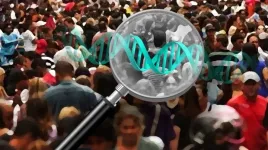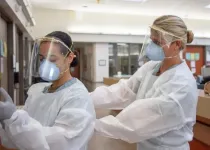(Press-News.org) Philadelphia, February 1, 2021 - Researchers at Children's Hospital of Philadelphia (CHOP) have demonstrated that autism spectrum disorder (ASD) may be caused by defects in the mitochondria of brain cells. The findings were published online by the Proceedings of the National Academy of Sciences.
Multiple studies have revealed hundreds of mutations associated with autism spectrum disorder, but there is no consensus as to how these genetic changes cause the condition. Biochemical and physiological analyses have suggested that deficiencies in mitochondria, the "batteries" of the cell that produce most of the body's energy, might be a possible cause. Recent studies have shown that variants of mitochondrial DNA (mtDNA) are associated with autism spectrum disorder.
The study team hypothesized that if defects in the mitochondria do predispose patients to ASD, then a mouse model in which relevant mtDNA mutations have been introduced should present with autism endophenotypes, measurable traits similar to those seen in patients. For this model, the traits related to autism included behavioral, neurophysiological, and biochemical features.
"Autism spectrum disorder is highly genetically heterogeneous, and many of the previously identified copy number and loss of function variants could have an impact on the mitochondria," said Douglas C. Wallace, PhD, Director of the Center for Mitochondrial and Epigenomic Medicine and the Michael and Charles Barnett Endowed Chair in Pediatric Mitochondrial Medicine and Metabolic Diseases at CHOP, co-senior author of the study, with Eric D. Marsh, MD, PhD, attending pediatric neurologist, Division of Child Neurology at CHOP.
The researchers - including co-first authors Tal Yardeni, PhD and Ana G. Cristancho, MD, PhD - introduced a mild missense mutation in the mtDNA ND6 gene into a mouse strain. The resulting mouse exhibited impaired social interactions, increased repetitive behaviors and anxiety, all of which are common behavioral features associated with autism spectrum disorder. The researchers also noted aberrations in electroencephalograms (EEG), more seizures, and brain-region specific defects on mitochondrial function. Despite these observations, the researchers found no obvious change in the brain's anatomy. These findings suggest that mitochondrial energetic defects appear to be sufficient to cause autism.
"Our study shows that mild systemic mitochondrial defects can result in autism spectrum disorder without causing apparent neuroanatomical defects," Wallace said. "These mutations appear to cause tissue-specific brain defects. While our findings warrant further study, there is reason to believe that this could lead to better diagnosis of autism and potentially treatments directed toward mitochondrial function."
INFORMATION:
This work was supported by the Neurobehavior Testing Core at the University of Pennsylvania and the Intellectual and Developmental Disabilities Research Center at CHOP and Penn supported by grant U54HD086984. This work was also supported by National Institutes of Health grants MH108592, OD010944, and 5K12HD043245, U.S. Department of Defense grants W81XWH-16-1-0401 and PR202997, a grant from Accure, Inc., a CHOP K-readiness grant, and a CHOP Foerderer grant.
Yardeni et al, "An mtDNA mutant mouse demonstrates that mitochondrial deficiency can result in autism endophenotypes." Proc Natl Acad Sci U S A, online February 1, 2021. DOI: 10.1073/pnas.2021429118.
About Children's Hospital of Philadelphia: Children's Hospital of Philadelphia was founded in 1855 as the nation's first pediatric hospital. Through its long-standing commitment to providing exceptional patient care, training new generations of pediatric healthcare professionals, and pioneering major research initiatives, Children's Hospital has fostered many discoveries that have benefited children worldwide. Its pediatric research program is among the largest in the country. In addition, its unique family-centered care and public service programs have brought the 595-bed hospital recognition as a leading advocate for children and adolescents. For more information, visit http://www.chop.edu.
Scientists have identified a group of drugs that may help stop a leading cause of vision loss after making an unexpected discovery that overturns a fundamental belief about DNA.
The drugs, known as Nucleoside Reverse Transcriptase Inhibitors, or NRTIs, are commonly used to treat HIV. The new discovery suggests that they may be useful against dry macular degeneration as well, even though a virus does not cause that sight-stealing condition.
A review of four different health insurance databases suggests that people taking these drugs have significantly reduced risk of developing dry macular degeneration, a condition that affects ...
A 15-year experiment on Arctic shrubs in Greenland lends new understanding to an enduring ecological puzzle: How do species with similar needs and life histories occur together at large scales while excluding each other at small scales? The answer to this question has important implications for how climate change might shift species' distributions across the globe.
The study was published today in the journal PNAS and led by the University of California, Davis. Its findings also reveal trends related to carbon sequestration and carbon exchange as the Arctic becomes both greener and browner.
EXPANSION AND EXCLUSION
Like lines of traffic traveling the same roads at the same time without crashing into each ...
CLEVELAND - Evidence suggests particulate matter is the air pollutant which poses the greatest threat to global health. Studies have shown that exposure to particulate matter smaller than 2.5 microns is associated with acute and chronic elevations in blood pressure (BP) as well as hypertension. In the study "The Benefits of Intensive Versus Standard Blood Pressure Treatment According to Fine Particulate Matter Air Pollution Exposure" published this week in the journal Hypertension, researchers at University Hospitals (UH) and Case Western Reserve University (CWRU) ...
A paper by a multidisciplinary team of scientists affiliated with various Brazilian institutions, including the University of São Paulo (USP) and the National Cancer Institute (INCA), shows that people of African descent are less likely to find a donor in the National Register of Voluntary Bone Marrow Donors (REDOME) than people with predominantly European ancestry. The paper is published in Frontiers in Immunology.
REDOME is the world’s third-largest bone marrow bank, with more than 5 million registered voluntary donors.
According to the study, having mainly African genetic ancestry can reduce a person’s chances of finding a donor by up to 60%, and having African copies of HLA genes, which must be compatible with ...
Obesity and its duration are significant risk factors for type 2 diabetes, cardiovascular events, multiple cancers and decreased quality of life. According to the Centers for Disease Control and Prevention, obesity affects 20.6% of adolescents ages 12-19 in the United States, meaning a potential lifetime of dealing with this condition. Complications from obesity can also result in a potentially decreased life expectancy of five to 20 years for these youth. In a new study published in Pediatrics, researchers at Children's Hospital Colorado (Children's Colorado) have found that both younger and older adolescents have similar weight loss, resolution of high blood pressure and high cholesterol, nutritional impacts and improvement in quality of life after bariatric surgery. These results ...
Article Title: "Game theory to enhance stock management of Personal Protective Equipment (PPE) during the COVID-19 outbreak"
Funding: The authors received no specific funding for this work.
Competing Interests: The authors have declared that no competing interests exist.
Article URL: https://journals.plos.org/plosone/article?id=10.1371/journal.pone.0246110
INFORMATION: ...
Decoy protein intercepts spike of coronavirus
Virus prevented from infecting human cells
Protein may be new way to treat and prevent COVID-19
CHICAGO --- Northwestern Medicine scientists have developed a new protein that acts as a trickster to neutralize the COVID-19 infection in a human kidney organoid, a miniature organ made from stem cells in the lab.
The protein is a variant of ACE2 (angiotensin converting enzyme-2), the receptor the coronavirus uses to enter and infect human cells. The modified protein intercepts the S spike of the coronavirus and fools it into binding to it rather than the real ACE2 receptor in cell membranes. ...
NEW YORK, NY (Feb. 1, 2021)--Errors in the way chromosomes are packed into antibody-producing B cells appear to play a role in the development of B cell-related blood cancers, according to a new study by researchers at Columbia University Vagelos College of Physicians and Surgeons.
The findings could lead to new biomarkers for predicting the onset of these cancers and to a new class of cancer therapies that prevent or correct harmful changes in genome architecture.
The study was published online Feb. 1 in the journal Nature Genetics.
Antibodies are made by immune cells called ...
Taking a particular type of medication to treat enlarged prostate is associated with a reduced risk of developing Parkinson's disease, according to a large observational study led by researchers at the University of Iowa, with colleagues in Denmark and China.
The findings, published Feb. 1 in JAMA Neurology, provide compelling evidence that terazosin, and similar medications, might have the potential to prevent or delay the development of Parkinson's disease.
The new study used data on almost 300,000 older men from two large, independent patient datasets--the Truven ...
A new kind of wearable health device would deliver real-time medical data to those with eye or mouth diseases, according to Huanyu 'Larry' Cheng, Dorothy Quiggle Career Development Professor in the Penn State Department of Engineering Science and Mechanics (ESM).
Cheng recently published a paper in Microsystems & Nanoengineering on new micro- and nano-device technology that could revolutionize how certain health conditions are monitored and treated.
"We sought to create a device that collects both small and large substances of biofluids such as tears and saliva, which can be analyzed for certain conditions on a rapid, continuous basis, rather than waiting on test results from samples in a lab," he said.
The sensors would be placed near the tear duct or mouth to collect samples, ...




